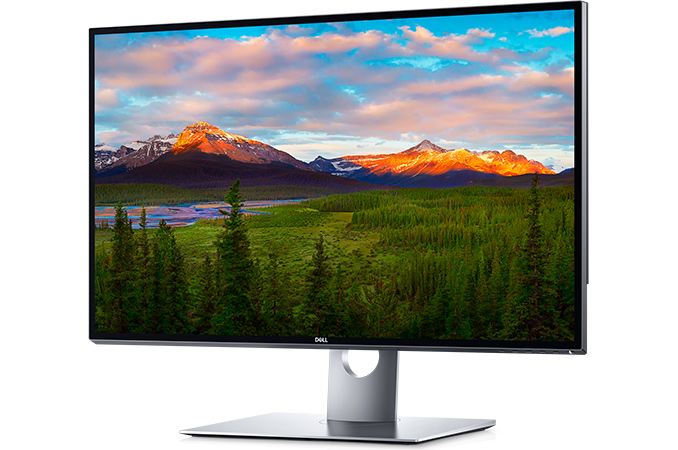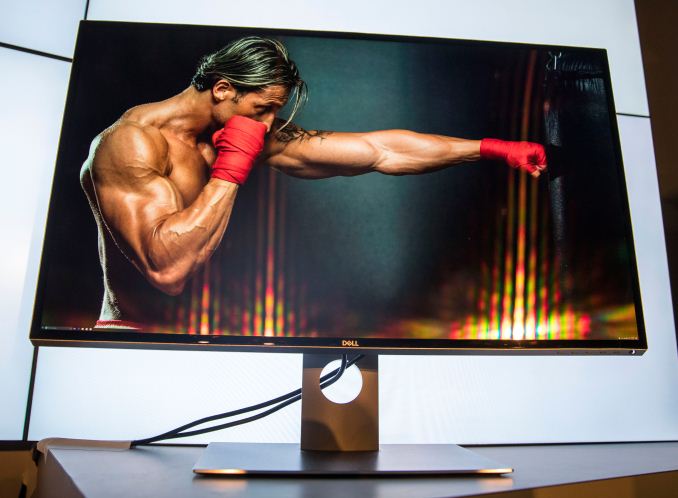Dell Announces UP3218K: Its First 8K Display, Due in March
by Anton Shilov on January 10, 2017 1:00 PM EST- Posted in
- Monitors
- Displays
- Dell
- Trade Shows
- UHD
- Ultrasharp
- 8K
- CES 2017
- UP3218K

Dell introduced the industry’s first mass-market 8K display aimed at professional designers, engineers, photographers and software developers. The UP3218K will be available this March, but its rough $5,000 price tag will be rather high even for professionals dealing with content creation. That being said, $5K or so was the price that the original 4K MST monitors launched at in 2013, which perhaps makes this display price more palatable. On the other hand, right now an 8K professional display is such a niche product that the vast majority of users will have to wait a few years to see the price come down.
Up to now, 8K reference displays were available only from Canon, in very low quantities and at very high prices. The displays were primarily aimed at video professionals from TV broadcasting companies like NHK, who are working on 8K (they call it Super Hi-Vision) content to be available over-the-air in select regions of Japan next year. A number of TV makers have also announced their ultra large 8K UHDTVs, but these are hardly found in retail. Overall, Dell is the first company to offer an 8K display that can be bought online by any individual with the money and be focused on the monitor market rather than TVs.
At present, Dell is not publishing the full specifications of its UltraSharp 32 Ultra HD 8K monitor (UP3218K), but reveals key specs like resolution (7680×4320), contrast ratio (1300:1), brightness (400 nits), pixel density (280 ppi) as well as supported color spaces: 100% Adobe RGB and 100% sRGB.
| Preliminary Specifications Dell UltraSharp 32 Ultra HD 8K (UP3218K) |
||
| Panel | 32" (IPS?) | |
| Resolution | 7680 × 4320 | |
| Brightness | 400 cd/m² | |
| Contrast Ratio | 1300:1 | |
| Refresh Rate | 60 Hz | |
| Viewing Angles | 178°/178° horizontal/vertical | |
| Color Saturation | 100% Adobe RGB 100% sRGB |
|
| Display Colors | 1.07 billion | |
| Inputs | 2 × DisplayPort 1.3 | |
For interconnection with host PCs, as a single DisplayPort 1.3/1.4 cable does not provide enough bandwidth for the 7680×4320@60 Hz configuration Dell is targeting, the UltraSharp UP3218K uses two DisplayPort 1.3 inputs to provide the necessary bandwidth, stitching the two display streams together internally using tiling. This is similar to early 5K displays, which used a pair of DisplayPort cables to get around the bandwidth limitations of DisplayPort 1.2. Using two cables not a big problem given the target market, but it's interesting to note that because 7680×4320@60Hz alone consumes all of the bandwidth supplied by the two cables, there isn't any leftover bandwidth to support HDR or the Rec. 2020 color space.
On a side note, while the company could have used DisplayPort 1.4's Display Stream Compression 1.2 (DSC) feature to reduce the bandwidth requirements of the monitor, they opted not to. DSC is promoted as visually lossless, but given how demanding many professionals are and problems that potential artifacts introduced by DSC could bring, Dell decided to stick to two DisplayPort cables as a result.
While a high display resolution is good for photos and images, it also makes everything smaller; and while modern operating systems support scaling, it does not work perfectly for all programs. It's likely that professional applications like AutoCAD or Photoshop will support 8K the day the UltraSharp UP3218K hits the market, but general use applications, already struggling with 4K and HiDPI in general, will be another matter. Practically speaking, if the price tag alone isn't convincing enough that this is a monitor for specific editing tasks and not for general desktop usage, then the lack of good HiDPI support elsewhere will. And while I'm sure someone will try to use the UP3218K as a gaming display, at four times the resolution of a 4K monitor, we're at least a few years off from GPUs being able to render high-fidelity games at a 33Mpix resolution.
Dell promised to start sales of the Dell UltraSharp 32 Ultra HD 8K monitor (UP3218K) on March 23 on its web-site. Initially, the monitor is stated to cost $4999. Time to put in some hardware requisition forms.
Related Reading:
- ASUS ProArt PA32U Display: 4K, 1000 Nits Brightness, 95% DCI-P3, 85% Rec. 2020
- LG Announces 32UD99: 4K IPS Display with 95% DCI-P3, HDR and USB-C
- BenQ Launches the SW320: a 4K Display with HDR for Professionals
- Panasonic Develops IPS Panel with 1,000,000:1 Contrast Ratio, 1000 Nits Brightness
- EIZO Launches ColorEdge CG2730 and CS2730 2560×1440 Displays for Professionals and Prosumers
- Dell Introduces UltraSharp UP3017 30-Inch Professional Display with 16:10 Aspect Ratio and DCI-P3 Color Space
Source: Dell













40 Comments
View All Comments
jordanclock - Tuesday, January 10, 2017 - link
The task bar is adorably small.stephenbrooks - Wednesday, January 11, 2017 - link
Didn't even notice it in the 2nd picture until I read your comment!boeush - Wednesday, January 11, 2017 - link
Next awesome peripheral to be announced by Dell: a head-mounted binocular microscope enabling serious professionals to actually work with this ridiculous display...enealDC - Wednesday, January 11, 2017 - link
good eye! I didn't even notice a task bar.lilmoe - Tuesday, January 10, 2017 - link
"It's likely that professional applications like AutoCAD or Photoshop will support 8K the day the UltraSharp UP3218K hits the market, but general use applications, already struggling with 4K and HiDPI in general, will be another matter."I wouldn't be too quick on the remarks of scaling. Check out the latest Windows 10 Insider build, and the new "Advanced Scaling" feature of GDI/GDI+ applications (basically, most Win32 applications). This screen should be out around the same time the Creators' Update is released.
BrokenCrayons - Tuesday, January 10, 2017 - link
It'd be easy enough to just run it at 3840x2160 so you still get a decent looking image inside of Windows if scaling or various applications don't play nicely with it.timbotim - Wednesday, January 11, 2017 - link
You've hit the nail on the head. This = 275dpi @ 32". If they want to make one about 60" to give 140-ish DPI, they can have my $5K, but not at 275dpi.imaheadcase - Tuesday, January 10, 2017 - link
I don't understand, so its NOT good for advanced scaling? I don't follow win 10 stuff much, but i know its terrible as it is.lilmoe - Tuesday, January 10, 2017 - link
I'm not sure why so many people are saying that Windows 10 is terrible. I've simply never used a better Microsoft OS. Most of the issues come from drivers; Intel graphics drivers specifically (Intel are STILL "working on it"). You need to try different driver releases from Intel and check which works best with your specific hardware.Back to topic, There's absolutely nothing wrong with Windows 10 scaling. Again, the problem lies with Windows' relatively "generous" backwards compatibility to run legacy applications. That being said, LOTS of current applications "claim" that they scale properly, but they actually don't. Windows 10 creators update _should_ be much better for scaling current and legacy Win32 applications for high DPI screens. The new feature *overrides* any and all application specific scaling, regardless if the applications claims it can handle it, and fixes blurry text and bitmaps.
It seems that devs at Microsoft rewrote/improved lots of the underling code of UI rendering. A nice additional benefit is that resizing windows is MUCH smoother, without stuttering and chopping.
lilmoe - Tuesday, January 10, 2017 - link
Side note: I'm personally very intrigued by a new, experimental battery saving feature that is supposed to "throttle" background and some foreground processes that aren't directly used by the user.The upcoming update should be pretty darn significant for the underlying code of Windows 10. The update after that should introduce some major UI improvements by the end of the year. Love it.